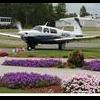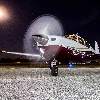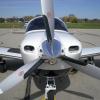Leaderboard
Popular Content
Showing content with the highest reputation on 08/06/2013 in all areas
-
Fly it a lot this year. My C ran $3100 in 2007 with 62 hours, -0- complex and a temporary certificate, along with several refusals to insure. With 100 Mooney hours at renewal, it dropped to $1600; now with IR and 500+ Mooney hours, I just renewed with Phoenix for $1000 with participation in FAA Wings and a recent MAPA PPP. First year required 15 or 20 dual including 5 instrument because I used a Mooney-experienced instructor whom they approved, otherwise it would have been 25 dual plus 10 solo. Be glad that rates have come down the last two or three years. Make good use of your dual time. Travel around, visit places you've never heard of. Land on runways that slope up, slope down, have humps or look like ski jumps while you have that CFI beside you. This will prepare you for traveling on your own. Learn the procedures, study the performance charts, and fly the numbers ±20 feet and ±1-2 knots. When you can make good landings at strange airports with unusual runways and unfamiliar ground references, then you will be ready to roam the country.3 points
-
Thanks again, Well I put 2.5 hours on "Second Chances" this morning. My friend had me do everything I do in the Pilatus PC-12. I kept looking for the autopilot. My left thumb is killing me It was a 135.293 check ride! I got myself so wound up with all the reading I have been doing for the last few months for nothing. Her landings were a non issue, even with a 15 to 17 knot cross wind. I actually crossed the numbers 5 to 10 kts fast and I didn't float into the fence on the other side of the field But now that I'm typing this, I do not think I did a full flap landing! DOH! I cannot thank you all enough for all the great advice I have absorbed reading all the fun topics. I cannot wait to fly her again, but alas, President Obama will be keeping me from flying tomorrow I REALLY REALLY LIKE MY MOONEY M20C! I want to go out to the field and look at her some more Where is that flashlight? David. (A very happy Mooney owner)3 points
-
Some pretty cool features added: ForeFlight Mobile 5.3 – our sixth significant release of the year – is now available for download from App Store. The team has put out some amazing updates this year, with a solid backlog of additional features lined up for releases throughout the rest of the year. This app update includes: Plate and taxi diagram map overlays: you can now overlay any of ForeFlight’s own 13,000+ geo-referenced diagrams and 700+ geo-referenced airport diagrams on the moving map. Flight Alerts: when filing IFR through ForeFlight, you’ll be updated when your expected route clearance is available. Then view it directly on the moving map or see your flight track on FlightAware after landing. A new Aerial map layer, providing a birds eye view of your route and lets you preview the terminal area. An enhanced instruments panel that shows eight instruments (on iPad in landscape) and has an improved design. Updated direct-connect drivers for Bad Elf and DUAL GPS devices, improving GPS performance and stability. Updated Stratus 2 firmware, which includes an enhancement that improves WiFi and high-altitude GPS performance. Plates on a Map and Taxi Diagrams on a Map (Pro Feature) This feature is one of the many products of our semi-annual Hack Week we held in Austin earlier this summer. With this feature, you can display any geo-referenced approach plate or taxi diagram right on the map. That means you get five fantastic new benefits: Track-up or north-up approach plates! When plates are on the map, you can fly them in track-up forward, track-up centered, or north-up modes. The ability to overlay both internet and airborne ADS-B or XM weather on approaches! Overlay flight rules, NEXRAD radar, and see weather conditions at nearby alternates. Approach plate hazard awareness for terrain and obstacles! If Hazard Advisor is active, terrain and obstacles are colored, raising situational awareness. Traffic information displayed on approach plates! If you have a Stratus or Stratus 2 portable ADS-B receiver and an ADS-B out equipped aircraft, see traffic targets displayed on the approach. Route overlay on top of approach plates! With the approach plate on the map, it is easy to add approach waypoints to your route that line up with the selected approach path.2 points
-
2 points
-
Likewise I don't do touch and goes any more either. While I don't think they are inherently unsafe they do add an additional element of risk to training with little to no benefit. But others do not see the added risk or feel they can properly manage it and I for one am not going to throw a stone at them. It's really a risk management decision and I am erring on the side of caution. We know there is added risk of an incident with T&G's because they happen. Never do them and you totally eliminate that risk. For me its an easy decision. But then I probably likewise engage in other operational tactics that others avoid and take on that added risk when compared to them. Its all about risk management and personal decisions and there is no right or wrong answer for everyone on this particular issue. Now flying into a thunderstorm, there is the same answer for everyone.2 points
-
I thought panel upgrades (A$pens) and the mooney cheap Ba$tard Club were mutually exclusive!!!2 points
-
When I was at Oshkosh this year I wandered over to the the Mooney tent area in the North 40 where the Mooney Caravan was tied down. Lots of Mooney owners and pilots milling about waiting for the BBQ. I didn't recognize anyone, even though I have been flying Mooneys for over 20 years, attended MAPA homecomings many times, and been a member of this forum and Mapalist (and the old West Coast MAPA). This was true at the Mooney booth as well. It would have been really helpful if pilots and owners were to wear some sort of name tag or Mooney badge. It would have been fun to match up some of the forum members with their faces. Of course, many of the panel folks at the larger EAA Mooney forum tent were people I know, but not very many of the general attendees. Maybe for next year, and for various Mooney functions, someone with more graphic talent than I have, could design some sort of of name tag with name and aircraft N number, and model - even a photograph of their aircraft.1 point
-
Here is a nice and detailed post from one of the 'other' Mooney lists: "Wednesday, July 31, saw an expanded Mooney Owners' Forum at EAA's Airventure. Organized and hosted by Dave Marten, Operations Director and board member of the Mooney Caravan, this informative question and answer session once again afforded Mooney pilots an opportunity to discuss all things Mooney. Representing Mooney Aircraft was CFO Barry Hodkin, who thanked Mooney owners and pilots for their strong support of the brand during these years without production. Mr. Hodkin afforded some needed insight into the realities facing any manufacturer re-entering the market, as well as some thoughts Mooney pilots had shared with him during AirVenture about products they's like to see Mooney produce. Mr. Hodkin also discussed Mooney's 96% delivery rate on parts support, something echoed by others as well. Two medical experts in flying and maintaining Mooney pilots also spoke: Drs. Bob Achtel and Chuck Crinnian (AME) opined on issues about keeping one's medical and maintaining fitness to fly. In addition to MAJ Marten, an Air Force test pilot at Edwards Air Force Base, other experienced Mooney pilots shared their insights about Mooney-specific flying. Experienced Mooney CFIs Don Kaye and Jerry Johnson discussed type-specific handling traits. Two global circumnavigators, three-time earth-rounder and world record holder CarolAnn Garrett and 20-year old youngest solo circumnavigator Jack Wiegand, each shared their perspectives on solo flight around the world in Mooney aircraft. And Chris Shopperly, President of the Mooney Caravan, excited the pilots in the crowd by previewing a short film of the 2013 Caravan arrival that was shot, arranged, and edited by his eleven-year old son, Mason, who received a rousing Mooney welcome. Whether it was due to the exciting footage in the short film is unknown, but Ms. Garrett announced she intended to participate in the 2014 Caravan to Oshkosh. Besides Marten, pilots Crinnian, Shopperly and Kaye also participated in this year's Caravan. The Caravan will be holding clinics and practice sessions around the country for Mooney pilots to fly their aircraft over the next twelve months until AirVenture 2014. Vintage Mooney Group discussed their opportunities promoting Mooney fellowship and creation of new chapters, Mooney Ambassador shirts and thumb drives were offered for sale, and ArtCraft Paint, a Santa Maria, California-based facility, described their expertise in having completed over 50 Mooney paint jobs. The Mooney Caravan to Oshkosh Education and Safety Foundation is a nonprofit Wisconsin corporation dedicated to active and safe flying of Mooney aircraft, and to organizing and promoting Mooney-related educational and social opportunities. Please watch our website mooneycaravan.com for upcoming events near you, and contact us at mooneycaravan@gmail.com. Share your Mooney pictures and see what other Mooney pilots are doing on mooneycaravan.shutterfly.com. Larry Brennan" ...and here is a post of mine from 5 years ago that I still believe strongly in: Posted by fantom on 23 October 2008 - 08:38 AM in General Mooney Talk Hi All. I sure hope this site takes off. As a long time Mooney list and MAPA list participant, it would be great to have an updated and consolidated place for Moony discussions, without all the wasted time those two take. Hopefully all three can merge. It's interesting to read the arguments of "senior" aviators on those two lists describe their relative merits. And they wonder why there have been few airframe or engine improvements in decades. ;-) Anyway, good to be here1 point
-
We were both in the Ovation. Mitch was left seat flying the formation . Probably 60 feet away. Experience of a lifetime1 point
-
1 point
-
Fly often and fly fast - congratulations on obtaining such a beautiful classic bird! PS. I am with Bob_Bellville - T-hangars-a-plenty here in Albemarle, NC (KVUJ) for $85/mo. or you can go deluxe for $200/mo. Most of the small airports around here will let you build your own hangar(s) with a 10-20-30 yr land lease that is very reasonable.1 point
-
Too true, and stop it. AOPA #533xxx You make me feel like a kid, Bob ;-)1 point
-
Hangers. We have relatively inexpensive, very nice, T hangers at a field run by the 2 counties and 2 towns who own the airport. The Airport Authority can get low cost money to add more hangers whenever the need is there. We added 8 new units this years. The only issue has been a few folks using their hanger as a storage unit after they no longer have a plane. Life is good @ KMRN.1 point
-
That may be so, but if this is the only thing the IA cited I'd still fly MY PLANE out of there signed off or not and never set foot in his hangar again. If anything ever came of it I’d cite that fact that it has been in the plane for X years and X IAs have looked at it and have not made any negative comments about it as well as the other arguments cited above. Heck he didn’t strap a 400SHP turbo prop on the front of the plane. I think this is a major problem with GA today for private planes something as simple as an EGT and IA wants to hold an owner hostage. These planes can fly with no electrical system and no engine gauges they are not necessary for flight. (well a battery to start the engine on the ground) They are nice to have a better picture of what is going on but not necessary for the engine to run or for flight. At the end of the day the PIC is the final authority that determines if the plane is airworthy, not the FAA, IA, FSDO or anyone else. These are our planes we bought with our money and it is high time the gov’t backs off some on what we can put in them. How many times have you gone to go fly and you notice something is not right and you scrub the mission for that day or you determine that you can make the flight safely? You are in charge and responsible for your plane.1 point
-
1 point
-
OK, consider this an interim PIREP (I'll explain later). Went flying after work today in an attempt to see if my carbureted C could be run LOP with my relatively new JPI 730. Leveled at 6500, 22" MP, and 2400 RPM ( this is my typical cruise setting). As a baseline I first tried leaning to my usual 20 degrees ROP which yielded around 9.6 GPH. I repeated this three more times with the same results regarding fuel flow, however, in three of the four attempts a different cylinder peaked first. I had noticed this in the past but was not sure what to make of it. Not sure what it means but I would rather think that my fuel distribution is probably pretty good for a carburetor. Next, I set the JPI in LOP mode and started leaning. The first cylinder peaked and went lean quickly followed by two more cylinders, but before the last cylinder went lean I started to feel a little roughness. By the time the last cylinder went LOP my fuel flow was 7.3 GPH. I had to enrich to a fuel flow of 8 GPH to eliminate all signs of roughness. I tried this 3 more times with similar results, just before or at the same time the last cylinder goes LOP I start to feel some roughness between 7 and 7.5 GPH, enriching to about 8 GPH clears the roughness AND CHTs were about 20 degrees cooler than when leaned to 20 degrees ROP (350 vice 370). So what does this all mean???? Well for one thing it looks like the method I was using before I got the JPI (lean to roughness and enrich a little) is probably the best method and I just wasted a bunch of money on a 730. Just kidding, glad to have the engine monitor for many obvious reasons. Now for the really stupid lapse of memory, I completely forgot to use carb heat in an attempt to make that last cylinder go lean without roughness. It was late and I was getting tired. So this is an interim PIREP until I try this again this weekend.1 point
-
1 point
-
I think that, particularly with respect to Mooneys which tend to be older aircraft, what is required to be in the aircraft and operating in the form of parts identical to those in the aircraft at the time it was certified, is a ocmplicated subject. I think that is particularly true of some of the gauge and instrumentation issues, such as this EGT question. All Mooneys (and other certificated aircraft) are born under a Type Ceritificate. The TC for all the M20's is at http://www.67m20e.com/Mooney TCDS 2A3 Rev 52 dtd 9DEC10.pdf . The "Required Equipment" list is in the TC. For the J, it says: In addition to the pertinent required basic equipment specified in CAR 3, the following items of equipment must be installed: 1(a)(1) or 1(a)(2), ( , ©, or 2(a)(1), 2( (1) and 1©, 101(a), ( , or ©, 102(a), 103(a), 104(a) or ( , 201(a), 202(a), 205(a), 206(a), 301(a) and 303(a), 301( and 303( , 302(a) or ( or ©, 401(a) or ( or © or (d) or (e) or (f) or (g) or (h) or (i) or (j) or (k) or (l) or (m), 601(a), ( or ©, 602(a) or ( or © or (d) or (e). Very helpful, right? BTW all the emoticons that show up are the websites translation of the footnotes, not my own. All of the numbers in the paragraph are footnotes to the TC that list items of equipment, makes and model numbers that can be used. In addition to the TC, the paragraph requires that the aircraft comply with CAR 3, which is the older version of the FAR's. There is a Basic Equipment provision at 3.655 which is the familiar "tomato flames" and that lists what (in addition to all the stuff in those footnotes) needs to be present in the aircraft and operating for the aircraft to be airworthy. There is also an "Equipment List" in the POH. However, that list is misunderstood. It is in the Weight and Balance section of the manual. For each piece of installed equipment, it shows the weight and arm of that piece. If something is removed or substituted that shows up on this list, a new weight and balance has to be created. However, the list does not say that the equipment in it needs to be operating for the aircraft to be airworthy, the equipment needs to be there and in its original location for w&B purposes. So you should go through the list in the TC and see if there is a requiment of an EGT gauge. I did a quick look through and I did not find one. And this, I believe, is key to the issue of whether an "STC'd as primary" gauge needs to be in the aircraft if the original gauge is removed. If something is "STC'd" for an aircraft, it simply means that it can be installed in the aircraft. So assuning a gauge is required equipment under the TC, you can have your original factory gauge in the plane, and also install a supplemental gauge like the EI, and it is perfectly legal. However, if a gauge is required equipment, it cannot be removed and replaced with something else unless the replacement is STC'd as the primary readout for that function. One of the issues with replacement is that many required equipment gauges are, by design, part of a system. So while you are thinking only in terms of the gauge itself, the gauge as installed as primary in a system, may have a backup and/or an annunciator and that system was part of the approval process. Further, if the substitute gauge has a different means of being powered up, let's say it is electrical while the original gauge was vacuum or pressure operated, then there may be a need in the FAA's eyes for some kind of monitoring or annunciator on the power source. If the alternator goes, you have no power for that gauge that was once powered by, let's say, vacuum, and there was an annunciator on the vacuum. Complicated. So the issue of what is supposed to be in a Mooney and operational is not so simple, and I think A&P's can be forgiven for sometimes applying what they may know about more modern aircraft systems, to Mooneys and other older aircraft. From my quick look at things, I don't think there is any requirement that a J have an EGT gauge, either in the TC/Required Equipment list, or in the CAR's of the FAR's that superseded them. That said, if the EGT was in the "Equipment List" of the aircraft and was removed without redoing the w&b you do have an airworthiness issue, there is no legal w&b. Another way of looking at it is to check the Limitations section of the POH. If there is a redline for an item you can bet there is going to be a corresponding gauge for a readout on that item and it is going to be part of the Required Equipment. I don't have a J manual, I have a K, but I don't see a redline on EGT's. Those are my thoughts.1 point
-
Jolie and Mitch posted many more of those AWESOME pics on Facebook! What a great opportunity to get some photos like that from a real pro. I made a last-minute trip to OSH with another Wichita Mooney owner and his wife. We left early Friday morning and returned late Saturday night, so it was short, but fully-packed with aviation goodness! We visited the Mooney booth for a while and had a nice chat with the current COO (I think that was his title, with duties to include truck driver and custodian!). Seeing M20 s/n 4 was a treat, as well as Jack W's world-rounder M20R, complete with a relief bottle still stowed behind the pilot seat! We got to catch up with Jolie and Mitch on Friday evening and it was great to see them again. The weather was PERFECT for the two days we were there. We got a great parking spot in GAC row #2, behind the warbirds. The shower/bathroom facilities seem better than in 2010, but the food quality was worse IMO, even though there were more concession areas it seems. I spent most of my time in the forums and the vendor exhibit buildings, so I missed much of the two airshows. I had a nice visit with a friend and former coworker that has created an incredible new wing and control system in conjunction with the inventor's son... http://lamaviation.com/2013/06/25/lam-aileron-demonstrates-improvements-in-aircraft-performance-aviation-breakthrough-to-be-showcased-at-eaa-airventure-2013/ This breakthrough as demonstrated with a Columbia shows lower stall speed, faster cruise speed (or 4 GPH fuel savings at equivalent cruise speeds) and 100+ lb structural weight reduction. I also learned the tail is now too big and it could be reduced in size as well yield further weight and drag reductions. Doing something like this on a Mooney airframe would certainly improve the M20 product line that seems to have reached the end of major evolutionary changes for now. Marauder... I do owe a PIREP on my east coast run and will try to do this week at some point before I leave for CO on Thursday or Friday.1 point
-
I was thinking that, too. We're just giving him a taste of aircraft ownership. lol1 point
-
On certified aircraft the FAA views each plane as meeting that criteria when signed off from the factory new. After that, any part of the plane must be shown to meet the original certification criteria. maintaining airworthiness is done by: 1. remaining the original OEM part as installed at the factory 2. PART 43—MAINTENANCE, PREVENTIVE MAINTENANCE, REBUILDING, AND ALTERATION a. STC - paperwork b. Major repair/modification - form 337 c. Minor repair/modification - log book entry there are no other choices. Example: as owner you can do preventative maintenance such as replacing light bulbs. This means removing the existing bulb and replacing it with the EXACT SAME BULB. If you put in a different bulb, you are MODIFYING the original design/certification and must comply with #2 above1 point
-
Wow! You should own an airport. That logic is exactly what is killing GA. Why not go one step further? Price it so you drive small planes out and cater to the corporate aircraft. That's exactly what happened to me. The reason airports don't build more is funding. If you want hangars, put together a group willing to build them (you know the 2 year waiting list guys) and present the offer to the airport. And BTW -- don't come back here whining that the Mooney part you need is $1,200. It's just supply and demand at work.1 point
-
Keep in mind that once you buy an aircraft, whatever model it is, it rarely makes $$$ sense to upgrade 1 step. My advice: buy the best aircraft you can comfortably afford, plan to keep it a long time and don't look back.1 point
-
If you avoid closing cowl flaps, don't reduce RPM, don't lean mixture, don't push them back in, don't extend flaps, don't set trim in order to make touch and go safer/easier... then you're not practicing real landings.1 point
-
According to a well known upper midwest MSC, under new ownership....."running lean of peak will wear out a set of cylinders on a J inside of 100 hours". .....the stupidity continues with the following statement "camguard is no good the last plane I changed oil on that had cam guard in it all the cam guard drained first out of the quick drain"......to be followed up with the dumbest statement I have ever heard especially coming from a MSC owner "LOP doesn't save any gas when you take into account you go slower".....ok wait this guy said one more hillarious comment "a Bravo won't run LOP because the engine is balanced so perfectly that it will only run ROP" .............. I couldn't get my plane out of there fast enough! I mean this guy was actually turning wrenches on my plane! Scary!1 point

























